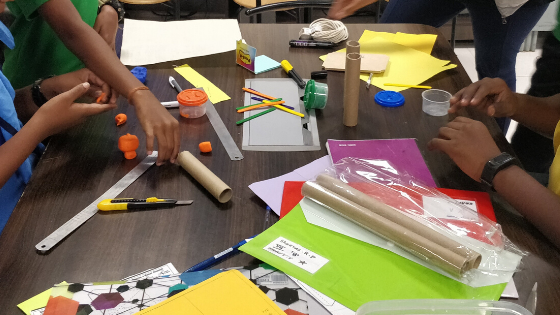
Post by India Implementation Lead, Prasanth Nori
Bengaluru, November 2019
As we began our 10-week journey of conducting a pilot of the Beyond Rubrics toolkit in an Atal Tinkering Lab (ATL) in Bengaluru, one of the things that we’ve had to do is to think of creating mini design challenges for our students so that they begin their journey of developing a maker mindset.
And as they begin their journey, we made a few visits to local hobby shops and office stationery stores to load up on some basic supplies. After spending about an hour doing these purchases, my mind was really tired.
We made lots of spontaneous decisions, balancing quality, quantity, brand, and budget, all while being mindful of time and sustainability of our effort. We needed to have most things that the kids would need for their challenges and more, because of the limited time students spend in a Makerspace. At the end of this effort, we had several bags of materials which we then needed to transport to the school, sort it and store it till the session began.
While this seems natural to most of us, there are thousands of teachers who are now required to keep a constant track of the makerspace inventory and do this task every other week. Added to that, most of these teachers are existing high-school teachers with fairly crowded timetables of teaching high school science, keeping a 24×7 watch on syllabus completion while constantly dealing with large classrooms of adolescents and their rapidly developing minds and bodies.
An inconspicuously harmless task of buying inventory for the makerspace is actually about 3 hours of work in a timetable where the time just doesn’t exist. Added to that, most teachers are expected to spend this money out of their own pockets first and then apply for a reimbursement with supporting bills. Most reimbursements again require additional paperwork, filing, and uploading. Even after this, payments are notoriously delayed.
Not very appetizing, is it?
The point I’m trying to drive here is not that we need to increase teacher accountability, increase efficiency or ‘change the system’.
It is to recognize that the ‘Maker Movement’, ‘Makerspaces’, ‘Tinkering spaces’, ‘Innovation Labs’, etc are great attempts at changing the system. However, they come with as much mundanity and effort as anything else out there that’s trying to make a difference.
If civil society, non-profits, corporate social responsibility teams, and citizens wish to make a difference, there’s more to be gained from focusing their efforts by either:
- Sponsoring or hiring a full-time facilitator for the makerspace who has the dedicated mental and physical energy of keeping these spaces functioning effectively.
- Creating long-term engagement programs that focus on easing this mundanity by sharing the load of procuring and managing inventory, maintaining equipment and providing opportunities for greater exposure for the teacher in charge of the makerspace.
- Creating programs that consider students not just as ‘consumers’ of the makerspace movement but also as active contributors. To create a strong sense of agency, we must allow students to take on the responsibility and shared ownership of running the makerspace – especially the tasks that they can easily fulfill like keeping an eye on inventory or maintaining schedules, hosting events, etc.
Having said that, I feel it is especially important to note that adding additional infrastructure or requiring existing makerspace teachers to simply ‘do more’ are sure-to-fail options.
In our work, we are thinking of ways to co-create some of these processes with the school. Sure, we’re there, for now, to source some materials and facilitate a few brief sessions in the Makerspace, but we are looking at ways to involve the school actively in everything we do inside the space. Here are a few ways we have been working on this piece:
- Our first design challenge is for students to understand that the makerspace is meant for the entire school (not just the students who are a part of our program) and so they’re working on creating maker and art installations around the school to ‘Invite everyone to the ATL’. This is a fun maker exercise for us and the students, but more importantly, aims at making the space more inclusive and open to the entire school.
- We are beginning to have conversations where social studies and science teachers in the school can use some of our embedded assessment tools during our sessions with the idea of involving them in our work. We’re then hoping to create a few teachers who are skilled at identifying and building maker elements and reflective abilities in students.
- Involving the Art teacher and other creatively-inclined teachers and staff to work with the makerspace as ‘experts’ who then guide a few student projects to completion. This invests more school team members to feel a sense of community in the school, enabled by the work in the Makerspace.
By doing these things, we are hoping to reduce the expectation from a single “makerspace-in-charge” and create a school community where teachers and students share the responsibility of running it effectively.
We’re looking forward to a great pilot and will be actively sharing more of our findings and insights in blog posts to follow!

